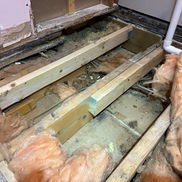
Understanding building investigations
Dealing with a building that has suffered from issues? Allow Richard Herrmann Associates Ltd to investigate the cause and advise the most suitable remedial action.
Utilise the knowledge of a team that understands what it takes to overcome these scenarios.
Combining structural expertise with building diagnostics
Building issues and/or movement is a concern that no property owner or manager can afford to ignore. Over time, buildings can shift or settle due to various factors, from subsidence and soil movement to poor construction practices or environmental influences. These shifts can lead to cracks, misalignments, or even structural instability, which could pose serious risks to safety and integrity. By conducting building investigations, Richard Herrmann Associates Ltd can help you quickly identify the causes and offer practical solutions to mitigate further risks.
Our engineers will begin by conducting a site visit assessment, which includes visually inspecting the property for telltale signs of movement, such as leaning walls, cracking or uneven floors. Our extensive experience allows us to assess the nature, direction and pattern of movement, leading us to focus on the likely cause(s). We also employ diagnostic tools where appropriate, such as laser monitoring systems, crack monitoring devices, and precise levelling equipment. These tools allow us to track even the smallest movements in a building, helping to forecast potential future risks and inform the best course of action. By employing technology, we can avoid guesswork and deliver solutions based on hard data.

Helping you rectify structural movement
Once the main cause has been identified during our initial checks and subsequent investigations, we’ll look to offer clear, actionable recommendations for remediation. This could involve strengthening foundations, repairing drainage, or addressing external factors such as nearby vegetation – understanding that the ‘one-size-fits-all’ approach can leave room for error, the solution will depend on the individual structure. From here, we’ll help you make the necessary adjustments, ensuring the integrity of the building is restored with minimal disruption and that future proofing measures have been considered. Building movement is not an issue that resolves itself. It requires expert analysis and a targeted approach for the safety and longevity of the property. By partnering with Richard Herrmann Associates Ltd, you can be confident that your building is in capable hands.
Drawing on our locality to understand foundational issues
It is quite common to assume that the underlying ground is strong enough to support the proposed building or loads, however there is much more to consider than you might think, particularly when the soil is cohesive in nature. Being located in Cambridgeshire, East Anglia, a region that has some of the most challenging ground qualities in the UK, we’re well versed in dealing with different soil types. Only after determining the soil type, in conjunction with any current or recently removed vegetation, can the most suitable and appropriate foundation solution be determined. This decision also needs to include consideration of buildability, health and safety, cost, timescales, site access, loads to be supported, and other factors unique to your development. That’s why Richard Herrmann Associates Ltd can prove invaluable.


37
Years Est.
6,500+
Clients
100+
Years' Experience

Happy clients we’re supported

Case Study: Examples of Housing Stock Issues
Having provided our investigation and inspection services to our Housing Association clients for many years, there is not much that we haven't seen. The following examples provide some insight into the nature of issues that we can identify and assist with.
Understanding Common Building Defects – and How Professional Investigation Protects Your Property
Across many of the properties we assess, owners first contact us after noticing subtle but worrying signs: a crack that seems to widen over time, a floor that doesn’t feel quite level, or timber that looks softer than it should. These symptoms often raise important questions—Is this serious? What’s causing it? And what should I do next?
In our experience of providing these services to Housing Associations and property owners, we have been asked to investigate such issues on many occasions and have developed extensive experience as a result. While each defect looked different on the surface, they all pointed to a familiar underlying theme: buildings respond to their environment, and over time, that response can reveal itself in movement, moisture, or material deterioration.
Our Investigative Approach
When we arrive on site, our first goal is to understand the building as a whole—how it was constructed, how it has aged, and how the identified issues fit into the broader structural picture. Through a combination of visual assessment, precise measurement, and, where needed, specialist testing, we’re able to determine not just what is happening but why.
Our engineers examine cracking patterns, areas of suspected timber decay, and elements that appeared out of alignment. By assessing these indicators together rather than as isolated problems, we are often able to trace their root causes and evaluate any associated risks.
Providing Clear, Practical Advice
A major outcome of every investigation is clarity. Once the structural behaviour is understood, we prepare practical and prioritised recommendations tailored to the specific building. This may involve targeted repairs, management, strengthening works, or coordination with qualified contractors for remediation.
For the building owner in these cases, our reports provided a clear roadmap—from immediate actions to long-term preventative measures—helping them make informed decisions with confidence.
Supporting Property Owners with Friendly Expertise
Structural issues can be stressful for property owners, but they’re also incredibly common. With the right expertise, most can be managed efficiently and cost-effectively. Our team combines technical knowledge with a friendly, collaborative approach, ensuring clients feel informed and supported at every step.
If you’ve noticed similar signs in your property—or simply want peace of mind—our engineers are here to help. Early investigation is always the most effective way to protect both safety and value.
CLIENT
Housing Associations
LOCATION
U.K.


FAQs

Safeguard your investment
If you suspect a structural issue, contact Richard Herrmann Associates Ltd via email or phone, or complete our online form below to share your project details.






















